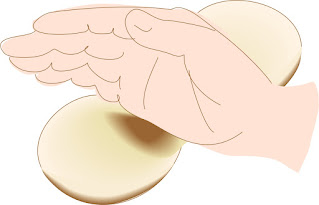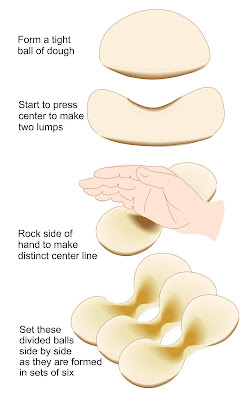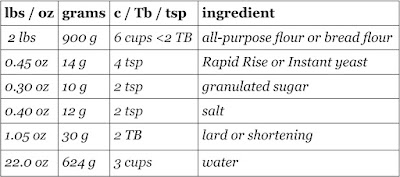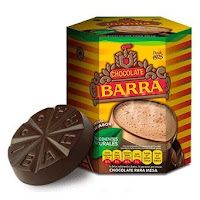| Guatemalan Pan Frances |
Everyone has their own style, their own methods; the things that work best for them, based on how they have done things over time, past experience. This is how it was for me. Making all the various Guatemalan style breads, which I truly only went into with some dedication last November, as I had been craving Shecas for ages! I watched videos to see the various styles for forming the breads, and then I did what worked best for me. My methods may or may not actually be "true," And then again, no two bakers make things exactly the same. While any professional baker will have their methods, tried and true, and teach these methods to students, there will always, always be variations. I say all this, because when anyone reads my methods, but might see something elsewhere that works better, then go for it. Comfort in your own methods is highly important in baking and cooking. This is where enjoyment starts.
| Pan Frances Just Baked |
French Bread, and Pan Francés
Okay, so when things actually come down to the fine brass tacks, there are not many ingredients in any French bread. True French bread needs nothing more than flour, yeast, salt and water. Additions, such as lard or shortening, if used, should be kept to a minimum. Sugar truly has no place in French bread, but most recipes I read for Guatemalan Pan Francés has at least a little of both of these latter ingredients.Forming the Dough
When I lived in Guatemala, I was married to a Guatemalan man, and for a brief moment in time, he owned a bakery. Once, when he took me through it, my memory of what I saw was of a baker forming Pan Francés. He already had a line or "set" of the breads formed, with the deep "dent" down the center. He had a heavily floured baker's "couche" set at one side, with a deep pleat upwards. He flipped the line of formed breads so that the pleat in the couche was poking into the line down the center of the breads and there it would rise. I know the reasoning for this - the bread just wants to rise and fill that deep dent, and if allowed to do this, then the bread no longer looks like the Guatemalan Pan Francés, but instead becomes a single blob. Not Good. And not everyone has a handy baker's couche. |
| Pressing the center of one set |
For a home baker, with less experience of making these breads, I was determined to get them right, and after seeing on many videos how very important it was to make that center in the line of breads is deep enough to stay open, I worked at it. Most videos show that once the line of usually 6 "sets" of breads (6 is easier for the home baker to manipulate). Once the set is formed and that center line pressed wide and flat, entire set of breads is lifted and flipped over onto a good bed of flour. The set is flipped back upright to rise, but even then, if the center line starts puffing, flatten it again with the side of the hand or a rolling pin and sprinkle more flour into the crease. This center crease has to be much wider than one would think. Make sure it is at least 1½-inches wide, minimum.
Pan Francés
Makes about 4+ "sets" of 6 Pan Francés In a bowl, mix flour, yeast, sugar and salt together. Add in the lard and the water, reserving some of the water aside in case it is not needed. Begin stirring with wooden spoon or hands, incorporating the dry ingredients and lard together. Once dough comes together, turn out onto a clean, floured surface and begin kneading. Adjust the dough with more flour or more water if needed. The dough should be tacky, but not outright sticky after a few minutes of kneading. Knead the dough until it forms a windowpane: take a piece of the dough and stretch it wide between the hands. It should be able to hold without tearing and stretch thinly enough to show light through it. For me, this took 16 minutes.
In a bowl, mix flour, yeast, sugar and salt together. Add in the lard and the water, reserving some of the water aside in case it is not needed. Begin stirring with wooden spoon or hands, incorporating the dry ingredients and lard together. Once dough comes together, turn out onto a clean, floured surface and begin kneading. Adjust the dough with more flour or more water if needed. The dough should be tacky, but not outright sticky after a few minutes of kneading. Knead the dough until it forms a windowpane: take a piece of the dough and stretch it wide between the hands. It should be able to hold without tearing and stretch thinly enough to show light through it. For me, this took 16 minutes. Grease a clean bowl and set the dough into the bowl, turning over once to grease both sides. Cover the bowl with plastic film and set aside to rise until nearly doubled. This can take 40 minutes to 1+ hours, depending on the ambient temperature.
Grease two or more baking sheets, or line them with parchment.
| Two sets of 6 breads set to rise |
Repeat this process with the remaining dough balls. There should be a minimum of 4 sets of 6 breads, though there could be an off-number set left.
Cover the heavily flour dusted breads with plastic film and set aside to rise for about 40 minutes.
Preheat the oven to 425 degrees. On a rack at the top of the oven, set an oven safe pan for steam-water.
Once oven is ready, have one cup of boiling water ready at hand. Set one tray of bread into the oven on center or lower rack. Quickly, pour the cup of boiling water into the steam pan on upper rack. Close the oven door and bake for 20 to 30 minutes, until golden brown.
With more trays, repeat adding boiling water to the steam pan on upper rack, then bake additional trays for the same amount of time.
My passion is teaching people how to create a harmony of flavors with their cooking, and passing along my love and joy of food, both simple or exotic, plain or fancy. I continue my journey in ethnic and domestic cuisines, continuing my journey to explore diverse culinary experiences and hopefully to start you on a journey of your own. Join me also at A Harmony of Flavors on Facebook, and Pinterest.


